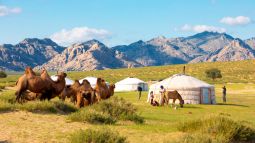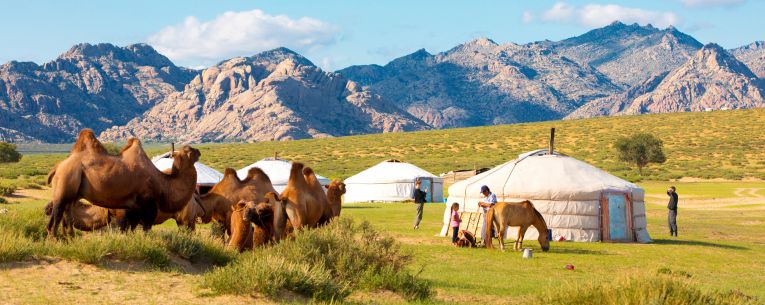One of the most meaningful experiences of travel is completely immersing yourself in the culture of your host country by living as the locals do. Staying in traditional accommodations instead of corporate hotels will give you a first-hand look at both historic and modern ways of life in your destinations. Imagine visiting a 500-year-old hacienda near Mexico City, or a houseboat in Kerala, India.
Wherever you roam in the world, purchasing travel insurance is an essential precaution. You should know that your domestic health insurance plan may not fully protect you abroad. An Allianz Travel Insurance plan with emergency medical and transportation benefits may help fill protection gaps. We also offer trip cancellation and interruption benefits that can reimburse certain non-refundable expenses in case your trip is canceled for a reason included in your policy.
Learn more about the history and modern-day existence of traditional accommodations around the world and where to book your next stay for an authentic experience.
Japanese Ryokan
Omotenashi (hospitality) is a cherished attribute of Japanese society. For a warm welcome and considerate attention to your needs, book a stay at a traditional Ryokan, a traditional Japanese inn. Dating back to the 8th century, Ryokan may be one of the oldest forms of hotel in the world.
“Japanese ryokan can range from the traditional to modern, from sprawling resort to private villa retreat, onsen (hot spring bath) ryokan to urban establishment,” writes Japan. Endless Discovery.
However, there are common elements often found throughout Ryokan; private baths, sometimes outdoors in scenic, but cozily secluded locations, yukata (robes) for comfortable lounging, and generous regional kaiseki (multi-course) feasts. When you’re done relaxing for the day, roll out your traditional, futon bed over fresh tatami (straw mats).
Ryokan with private and public onsen, either inside or outside, could easily be the highlight of your travels in Japan. Subterranean volcanic activity heats Japan’s vast network of hot springs that fill onsen and are known to contain minerals that nourish skin and improve blood circulation.
Must visit Ryokan:
Shibu Onsen Kokuya is located in the small hot spring town Shibu Onsen, known for nearby Snow Monkey Park, where hundreds of wild Japanse macaque monkeys venture down from the mountains to escape the cold by lounging in the area’s hot springs. When you’re done watching the monkeys up close, lounge in your own hot spring bath at Shiba Onsen Kokuya, operated and the same family over 16 generations.
Sekizenkan Honkan in Shima Onsen will be instantly recognizable to fans of the Studio Ghibli film Spirited Away. One of Gunma prefecture’s cultural landmarks, Sekizenkan Honkan is said to be the inspiration for the animated film’s fictional bathhouse, known to cater to mystical clients from the spirit world. In the real world, visitors to the ryokan can relax in several open-air onsen surrounded by mountain forest scenery. Kashotei, the ryokan’s main building, was constructed in 1691.
Moroccan Riad
Don’t be fooled by the modest outside appearance of the Riad, a traditional Moroccan dwelling marked by opulent courtyards and gardens surrounded by protective, simple walls. Once the homes of wealthy elites, Morocco’s large number of Riad now serve as luxury guest houses, emblems of classical Moroccan architecture and cultural history.
Imagine finding a hidden sanctuary on the busy streets of Marrakech. You walk up to an ordinary building that belies the beauty behind its walls.
“A simple door, just like all the others, can hide the most surprising and beautiful guesthouse,” writes Experience It Tours. “Many riads will only have a small sign on the street where they’re located. Don’t assume that the gorgeous riad you will stay in is easily visible from the street. The secret beauty is part of the charm."
Inside is an open-air courtyard of intricately carved stone and tile work. Your eyes are drawn to a central fountain and landscaped gardens. The emphasis on privacy in the Islamic culture gave rise to the beautiful interior spaces of Riad, which allowed families and friends to socialize in seclusion.
Aside from being a tranquil place to relax and connect, a central courtyard also serves the practical purpose of allowing cool air to enter the building. Today, riad have air conditioning. Riad are known for their warm hospitality and great food. Larger Riad often feature pools and spas.
Must visit Riad:
Riad & Spa Dar Bensouda is an architectural gem in Marrakesh dating to the 16th Century. Lounge in the spacious, ornate courtyard and rooftop terrace common areas. Take a dip in the patio pool before enjoying a traditional Moroccan meal. Guests can also be pampered at the hammam and spa onsite.
Dar Aicha, is a charmingly quaint Riad that will give you a real feel for living in a traditional Moroccan home. Rent the entire apartment with family and friends to gather in cozy common areas, before seeking some rejuvenating private time on the rooftop terrace and private balcony. Guests say they love the food and attentiveness of the innkeeper. Visit the nearby hammam and pottery and cooking workshops.
Mongolian Ger
The Ger is a marvel of practicality without and beauty within. These traditional homes, often referred to by tourists as yurts, are designed to be portable, fitting a traditionally nomadic lifestyle. Ger is the word used for all homes in the Khalkha Mongolian language but originally applied to the traditional tent dwelling.
Ger are clad in several layers of sheep or goat felt in the winter, and a single layer in the summer to withstand the harsh temperatures of the Mongolian steppes. Inside are intricately decorated red, blue and green wooden structures that support the Ger. Wooden furniture crafted in a blend of Russian and Asian styles makes a Ger warm, comfortable and inviting. Bright carpets cover the floors.
The khana is a unique focal point at the center of a traditional Ger with a practical purpose. A decorated wooden opening in the roof, or toono, of the Ger, the khana provides ventilation and releases smoke from a central stove.
If you are visiting a traditional Ger, you will be warmly welcomed. “At their home, they will always have some tsai (traditional salty milk tea or black tea) which is offered first to a guest in respect and some food (usually traditional biscuits), some small bread pieces, and dairy products ready to be offered to the possible unscheduled guest,” writes Ayan Travel Adventures in Mongolia.
Must visit Ger:
The best way to experience living in a Ger and the traditional, nomadic lifestyle of Mongolia is to stay with a host family. Book a Ger from a local family and experience what life is like for people who still live a nomadic life outside of Mongolia’s cities. As many as 30 to 40 percent of Mongolians live nomadically and support the livestock herding economy, with the estimate varying depending on the source.
Get a quote for travel insurance protection for your next trip.
Related Articles








Share this Page